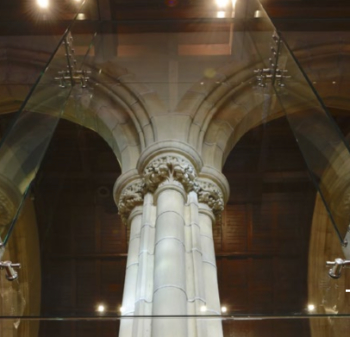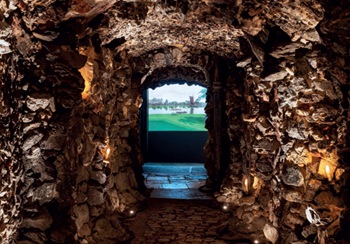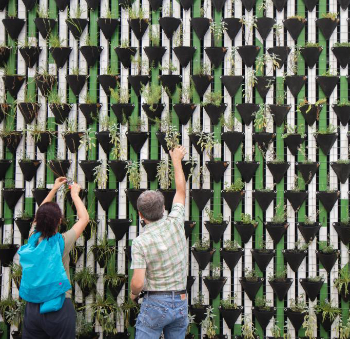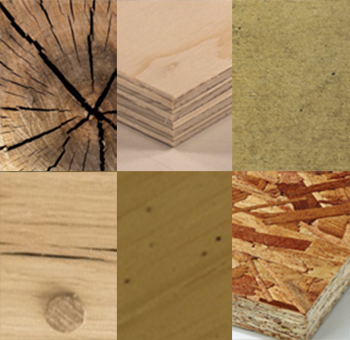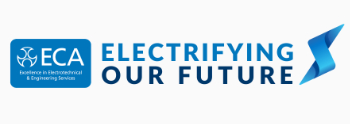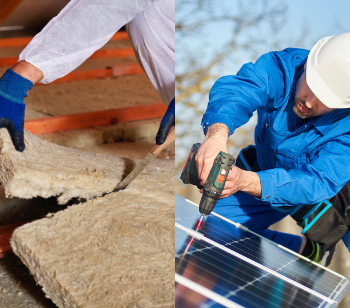Digital sustainability through future AEC tools: bringing together industry and academia
Contents |
[edit] The climate context
The built environment sector is under increasing pressure to operate in sustainable ways, pursuing profitability while contributing to the wider ecosystem through economic, social and environmental goals. To fulfil our obligations under the Paris Agreement and achieve net-zero by 2050, we must engage a critical mass of firms to support them in decarbonising the construction process. A critical focus of this mission is doing this through minimising emissions and waste generation, as well as building with less materials for more humans.
[edit] Overcoming the challenges
This pursuit is not without its challenges. Issues such as tight project deadlines, budget constraints, and a low tolerance for risk often clash with innovative solutions for sustainability-driven processes, services, and products. To effectively achieve policy targets, it is crucial we transform decarbonised construction from a customised approach to a widespread market solution. The Architecture, Engineering, and Construction (AEC) sector must undertake a coordinated effort to effectively address these challenges, understanding the intricate relationship between digital technologies, sustainability and the required practices and capabilities.
Australia’s foremost Architecture, Design, and Engineering (ADE) practices and professional bodies have come together to establish the ARC Centre for Next-Gen Architectural Manufacturing (Arch_Manu ITTC). We aim to transform the national architectural, design, and engineering professions to meet Australia’s immediate strategic needs in terms of productivity and climate goals. Being a partnership between academia and industry, we will triangulate world-leading researchers, visionary practitioners, and talented graduates to integrate state-of-the-art research into practice. Our program of twenty-five industry-embedded PhDs, national and international placements, short courses and three postdoctoral projects is positioned under a digital sustainability framework. It will grow architectural manufacturing knowledge, skills, and capacity within the Australian and global AEC sector, while delivering novel architectural manufacturing-specific design tools and frameworks for the sector.
[edit] Meanwhile, on the other side of the world…
While the Arch_Manu ITTC was taking shape, a parallel conversation on the other side of the world was shaping the framework for it to align its trajectory to. This was the Future AEC Software Specification.
The conversation initiated with a cohort of digital leaders from UK-based architectural practices, coming together to share thoughts and insights from the experiences in the field of architectural design technology. Amongst common issues was a frustration with the slow pace of change in some of the more prevalent design platforms on the market and, provoked by an evolution of licensing models, the group were motivated to write and publish the first open letter to Autodesk.
The letter started a wider conversation around software and its role within the AEC industry and gave rise to a broader dialogue encompassing the US and Europe, as well as spawning further open letters. Despite this, there was little to see in terms of meaningful progress from Autodesk and other major vendors. On the verge of writing another open letter, a couple of us decided to put forward a different approach. Instead of reacting to one well-established and entrenched software developer, we sought to start a more proactive open dialogue with the entire AEC software community.
With that in mind, a small group of UK-based architectural practices began to sketch out a vision of what the ideal software ecosystem would look like for a contemporary architectural industry. The intention was twofold: to make this vision, this specification, available to the industry to gain more feedback from peers; and to describe to the software development community and their investors exactly what the AEC industry, their clients, are looking for in terms of technological capabilities. Comprised of ten tenets across data, functionality, capabilities, and commercial, the specification intends to give the development community a checklist to align their efforts to.
The specification was launched by AHMM’s Aaron Perry in June 2023 at NXT DEV in London; a unique conference bringing together AEC firms, software developers and investors. Following the launch, the reception from both the AEC and the software industry has been remarkable. Whilst initially set out by UK- based architectural practices, firms from across the AEC spectrum, and across the globe, have reached out to lend voices of support and to offer their involvement. Similarly, a host of software companies, from big players to smaller start-ups, have been in touch to find out how they can both learn more and further align with the specification.
[edit] Aligning centre and specification
Back in Australia, we at the Arch_Manu ITTC are planning to develop and deliver these tools within the framework and thinking of the Future AEC Software Specification. We believe too in an open-source specification for future design tools that facilitate good design and construction by enabling creative practice and supporting the production of construction-ready data.
Our commitment to software and digitalisation is because digitalisation is undeniably one of the most powerful drivers of societal change. It offers the scalability and speed required to address the second societal change: climate change. We do not see digital and sustainability as separate but as a ‘twin transformation’ or ‘twin transition’, with an intersection in which digitalisation strengthen sustainability. We call this digital sustainability.
Digital sustainability distinguishes itself from traditional sustainability approaches already in use within the AEC industry. We believe that digital sustainability will be a driving force for a fair and prosperous future because all industry sectors can reach their climate and ESG targets with proper use of digital solutions. We understand digital sustainability for the ADE sector as a way forward to review and reimagine existing practices and capabilities to harness the potential of digital technologies, delivering organisational and societal benefits.
Our PhD students will investigate digital sustainability to enhance productivity and efficiency in the AEC sector, with the primary objective of bridging gaps in knowledge and practice through three interconnected architectural research and training themes:
- Synthesis of creative operational processes and practices in pre-design. This creates more efficient, reliable and effective software, making it easier for Australian manufacturers to complete new product designs.
- Management of business processes and commercial models. Rethink the standard business models of the architectural sector to consider new digital Anything as a Service (XaaS) models for influencing what to design and manufacture.
- Analytics unlocking the potential of architectural data in post-design. Use advanced computation to unlock the commercial potential and operational efficiency of existing and new data in CAD, BIM and other formats.
[edit] Closing the loop on industry
The involvement of both academia and industry at Arch_ Manu promises to bring an exciting depth of rigour and real-world experience as we investigate what the future technological landscape of the AEC industry looks like. Aspects of the Future Specification will evolve through PhD research before being tested and proven in an industry setting on real-world problems. By closing the loop in this way, we will make progress at a much faster rate than relying on the organic transformation of the industry.
After all, our industry carries a weight of responsibility in delivering a sustainable future, which technology is key to realising. This is the challenge we face, and we are excited to meet it.
This article appears in the AT Journal Issue 150 Summer 2024 as "Digital sustainability through future AEC tools: bringing together industry and academia" and was written by Associate Professor M. Hank Haeusler, Director, ARC Centre for Next-Gen Architectural Manufacturing (Arch_Manu) and Andy Watts, Director of Design Technology, Grimshaw, and Partner Investigator, Arch_Manu.
--CIAT
[edit] Related articles on Designing Buildings
- Achieving net zero in social housing.
- Aligning net zero with the levelling-up agenda.
- A zero-carbon UK by 2050?
- CIAT articles.
- CIAT podcast.
- Construction skills crisis threatens UK net zero goals.
- Evidencing Net Zero with the new UK buildings standard.
- Fabric first investigation into net zero for existing buildings.
- Infrastructure carbon reduction misses net-zero target.
- Low or zero carbon technologies.
- Making Mission Possible: report on achieving a zero-carbon economy by 2030.
- Nearly zero-energy building.
- Net Zero All Party Parliamentary Group NZ APPG.
- Net zero by 2050.
- Net zero carbon building.
- Net zero carbon emissions.
- Net zero strategy: build back greener.
- Planning the infrastructure transition to net-zero.
- Scotland publishes plans to reach net zero targets with Heat in Buildings Strategy.
- Skilled workforce unable to meet net zero ambitions.
- Smoothing the path to net zero.
- The UKs first net-zero carbon buildings standard
- Thermal imaging of the building fabric in the net zero world.
- Transform to Net Zero.
- UK’s first net zero carbon buildings standard
Featured articles and news
Focussing on the practical implementation of electrification.
Sustainable Urban Drainage and Biodiversity
Awards for champions of these interconnected fields now open.
Microcosm of biodiversity in balconies and containers
Minor design adaptations for considerable biodiversity benefit.
CIOB student competitive construction challenge Ireland
Inspiring a new wave of Irish construction professionals.
Challenges of the net zero transition in Scotland
Skills shortage and ageing workforce hampering Scottish transition to net zero.
Private rental sector, living standards and fuel poverty
Report from the NRH in partnership with Impact on Urban Health.
.Cold chain condensing units market update
Tracking the evolution of commercial refrigeration unit markets.
Attending a conservation training course, personal account
The benefits of further learning for professsionals.
Restoring Alexander Pope's grotto
The only surviving part of his villa in Twickenham.
International Women's Day 8 March, 2025
Accelerating Action for For ALL Women and Girls: Rights. Equality. Empowerment.
Lack of construction careers advice threatens housing targets
CIOB warning on Government plans to accelerate housebuilding and development.
Shelter from the storm in Ukraine
Ukraine’s architects paving the path to recovery.
BSRIA market intelligence division key appointment
Lisa Wiltshire to lead rapidly growing Market Intelligence division.
A blueprint for construction’s sustainability efforts
Practical steps to achieve the United Nations Sustainable Development Goals.
Timber in Construction Roadmap
Ambitious plans from the Government to increase the use of timber in construction.
ECA digital series unveils road to net-zero.
Retrofit and Decarbonisation framework N9 launched
Aligned with LHCPG social value strategy and the Gold Standard.
















